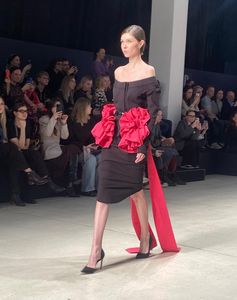A popular legend in Slavic folklore is the myth of Baba Yaga. She is a witch who lives in a forest, in a peripatetic house that stands on chicken legs. There are contradictory stories around her; some tales show her as a child-eating monster, but in others she is wise and kind. Russia enjoys the same reputation in geopolitics. Despite its superpower status for centuries—its strides in nuclear programmes, space, economics and of course literature (five literature Nobels)—its bent towards war-mongering has the west worried.
Each time I visit Russia, I fall in love with it a little more. Russians are warm and helpful; they are also a very happy country, proud of their excellent standard of living (a little money goes a long way here) and their clean streets.
I am at the Moscow Fashion Week again. It still does not have an official sponsor on its title (thanks to economic sanctions triggered by the Ukraine war), but it is unofficially backed by the government. It also invites several other countries to present here, including India, Turkey, Indonesia, Spain, China and South Africa. Russian fashion, much like Indian fashion, is at such an interesting juncture currently, where the rich oligarch-friendly opulence is giving way to a young and rebellious street-style.
The traditionalists are still attached to Russian culture: there are furs, leather, linen—materials used in the country’s national costumes. The newer lot is inspired by the nightclubs; clubbing in Russia is now a national activity. We need to remind ourselves once again that despite its breathtaking imperial edifices and gilt-edged streets, the Russian Federation was born only in 1991. This is a young country, finding its feet globally again, and making its voice heard. The irony is that, on the first day of the Moscow Fashion Week, Demna Gvasalia of Georgia (former the USSR) was appointed chief designer of the global giant Gucci.
There are a lot more Demnas where he came from. The last decade or so has seen Russia awaken to a new sense of style. Younger Russia is preparing new stars. Imkmode is one such rebellious label; its collection reminds one of Thierry Mugler and Balenciaga, and is eco-coded with references to recycled plastic.
Alexander Varlakov is a debutante designer here (his proud mum came out to hug him), and his show was such an exciting and modern take on traditional tailoring. All the international press present adored it.
I also loved the vibe at Rogov, a socialite designer of sorts. He is an influencer and a TV presenter (commenting on European red carpet and celebrity styles) who started his own fashion label three years ago. His personal style and that of his collection were incredibly well put together.
Maison Kaleidoscope by Katya Kombarova is also such a fun label. Her last show was inspired by a circus, with red, black and white colours. She made the grotesque tasteful, proving that Russian fashion enjoys a little chaos. I adore Red September, a street-inspired label that is finding favour with international celebrities like American actress Julia Fox. Yana Besfamilnaya had a show that had her Italian summer-inspired line presented in a trattoria setting, with cocktails dedicated to Ozempic.
Brenda Bizzi, the founder of the popular Italian trade fair White, is here at Moscow Fashion Week for the first time and she likes what she sees.
Russian fashion today does not speak of the Russian empire or the USSR; it speaks of its new citizens. It is a mirror to Russia’s new soul. It has taken old ideas and turned them into new things.
X@namratazakaria


